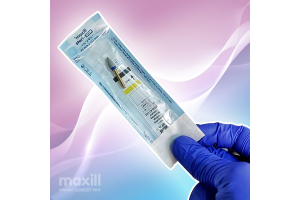The Union of Record Keeping and IPAC: The Need for a Revolutionary Approach to Digital Logging in Dental Offices

The Union of Record Keeping and IPAC
Record keeping is a vital part of any dental professional’s day-to-day tasks. There are a vast array of continuing education courses on record keeping, usually related to client care for thorough documentation with all the elements to satisfy the standards of practice.
The good old saying “if it isn’t written, it didn’t happen.” This plays a role in many systems and services of the dental office. Typically when the topic of record keeping is discussed, dental professionals immediately think of ‘chart entry’. However, parallel to the importance of a well-composed chart entry is documenting IPAC quality assurance in sterilization monitoring. “If it isn’t written, it didn’t happen” fully applies to IPAC.
Logging is a word dental professionals are very familiar with in the union of record keeping and IPAC. There are countless logs for numerous tasks.
Specific to sterilization monitoring the following is a best practice list of the data required to be logged:
- Office name
- Sterilizer name and model
- Date sterilizer was used
- Cycle type used
- Tally of the cycle type and load numbers
- Mechanical data of time, temperature and pressure of each cycle and load
- Chemical quality assurance testing parameters and outcomes: type I, II, IV & V chemical indicators
- Biological quality assurance testing parameters for negative or positive spore growth for both test and control vial
- Presence/use of a PCD for every cycle and load
- Contents of each load
- Proof of requalification steps
- Transparency of any sterilization failures to include error numbers where applicable
- Initials of the person placing instruments in the sterilizer
- Proof of a "pass" in sterilization monitoring in the clients’ clinical chart
The Need for a Revolutionary Approach to Digital Logging in Dentistry
There are two aspects of the union of record keeping and IPAC: office safeguarding and client safety. This involves two locations in the office: reprocessing area where the action of the QA testing and logging unfolds and the operatory where proof of sterilization is screened and documented.
Dental offices have mastered their systems for logging in the reprocessing area, however, the operatory task surfaced only a few years ago, thus requiring a fact vs myth discussion.
The question is; does an office need to document in the client file the data written on the instrument packaging?
Yes. Why?
It is a tracing mechanism in the event of an IPAC lapse where a recall of instruments is ordered. Who is stating a dental office needs to include this data in the client chart? Public health and dental regulatory bodies. Some guidelines and standards are clearer than others. In the latest updates in the province of Alberta, page 39 of the CRDHA IPAC Guidelines (212825 (crdha.ca)) state:
“load details for instruments used are recorded in the patient's chart in case of recall"
Thank you CRDHA for the clear message. The best advice I can give is to prove it to yourself!
Run a mock recall of instruments. Chose a date, sterilizer, and load number and ‘pretend’ the instruments attached to that load need to be recalled. How will you find those instruments? Semi-effective and efficient if the data is written in the client chart and fully effective and efficient if within a digital logging system.
Not so simple if the data from the packages are not documented for client tracing. Keeping in mind IPAC record keeping is umbrellaed by risk management. Finding instruments affected by an IPAC lapse requires a system that leaves no room for error. That translates to either missing notifying clients involved in the lapse and/or notifying by error clients not involved in the lapse. Both are HUGE risks that no office wants. Can this risk be mitigated? Good news, yes, and the answer is digital logging with barcodes that ensure accuracy with a system computer engineered with prompting screens loaded with the actual IPAC standards.
Introducing the Next Evolution In Dental Instrument Reprocessing and Tracking: steri-sox ST
maxill has revolutionized digital logging with a system written by dental professionals for dental professionals. Would you like a system that
- Guides users along the way in the unfortunate event of an IPAC lapse?
- Walks users through all the daily sterilization monitoring tasks?
- Prompts users when to requalify a sterilizer and the steps required in the situation of a failed CI and BI?
- Reminds users to check all indicators?
- Prompts the use of a PCD?
- Has the ability to recall on a kiosk screen a list of clients matched to instruments impacted by a recall?
- Cancels barcodes linked to a sterilization failure so if scanned will alert the clinician to not initiate use?
- Prints clear legible labels for packages?
- Prints every and any sterilization monitoring and maintenance log required from a central kiosk?
- Has the security of cloud backup storage operating apart from Wi-Fi to ensure internet interruptions do not halt or impact data?
- Acts as a central ‘computer’ in the reprocessing area for storage of IPAC and maintenance files?
maxill’s steri-sox ST can deliver all this plus much more! maxill’s dental professionals did not want to design a barcode scanning system that offers only the basics of sterilization monitoring and a fancy printer for labels, but rather one with a fully supportive system paralleled to the IPAC standards of practice. Why bother designing a basic barcode and scanning system when the technology can marry the mind of key IPAC expert leaders and deliver a progressive innovative product that is sure to not disappoint the user and surpass the expectations of any IPAC auditor?
The union of IPAC and record keeping should be just that, a union and not a collision. Safeguarding the office and client safety is what maxill’s steri-sox ST delivers 100%. Dental offices are facing labour shortages and are far too busy to operate without advanced technology in the reprocessing area and operatories. It is no longer a wish to implement a digital logger, but rather the next evolution phase of the dental offices' one-way workflow of instrument reprocessing and tracking!
Sources:
Crdha.ca. 2022. [online] Available at: [Accessed 30 June 2022]







